Why Do You Look Like Your Parents?
Have you ever wondered why you have your mother’s eyes or your father’s smile? Or perhaps why you’re the only one in your family with curly hair? The answer lies in one of biology’s most fascinating topics: inheritance.
Every single trait you possess-from the color of your eyes to your blood type, from your height to whether you can roll your tongue-has been passed down through generations via a remarkable molecular system. Understanding inheritance isn’t just about acing your IGCSE exams; it’s about understanding yourself, your family history, and even predicting the chances of genetic conditions.
In this comprehensive guide, we’ll unravel the mysteries of genes, chromosomes, and DNA. We’ll explore how characteristics pass from parents to offspring, why siblings can look so different, and how scientists predict inheritance patterns. By the end, you’ll be able to solve genetic crosses like a pro and appreciate the beautiful complexity of life itself.
Let’s dive into the world of genetics!
Understanding the Building Blocks of Inheritance
What Are Chromosomes?
Think of chromosomes as instruction manuals for building and maintaining your body. Located in the nucleus of nearly every cell, these thread-like structures contain all the genetic information needed to make you, well, you.
Key facts about chromosomes:
- Humans have 46 chromosomes in total (23 pairs)
- One chromosome from each pair comes from your mother, the other from your father
- 22 pairs are called autosomes (body chromosomes)
- 1 pair are sex chromosomes (XX for females, XY for males)
- Chromosomes are made of DNA (deoxyribonucleic acid) tightly coiled around proteins called histones
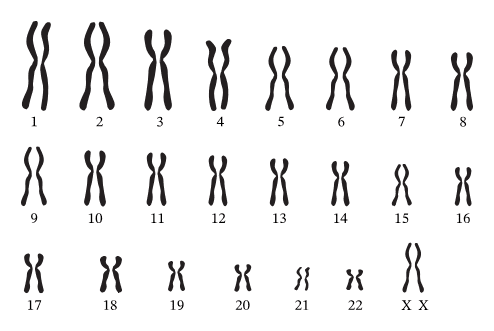
DNA: The Molecule of Life
DNA is the chemical that makes up chromosomes. Imagine it as a twisted ladder-the famous double helix structure discovered by Watson and Crick in 1953.
Structure of DNA:
- Sugar-phosphate backbone: Forms the sides of the ladder (made of deoxyribose sugar and phosphate groups)
- Base pairs: Form the rungs of the ladder
- Four bases: Adenine (A), Thymine (T), Guanine (G), Cytosine (C)
Base pairing rules (crucial to remember!):
- Adenine always pairs with Thymine (A-T)
- Guanine always pairs with Cytosine (G-C)
These complementary base pairs are held together by hydrogen bonds, creating a stable yet flexible structure.
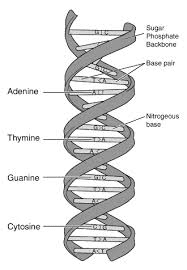
Memory Tip: Think “AT” (like the word “at”) and “GC” (like “Good Connection”) to remember which bases pair together!
Genes: The Units of Inheritance
A gene is a section of DNA that codes for a specific protein, which in turn determines a particular characteristic (trait). For example:
- A gene for eye color codes for proteins that determine pigmentation
- A gene for blood clotting codes for specific clotting factor proteins
- A gene for height influences growth hormones and bone development
Important terminology:
- Allele: Different versions of the same gene (e.g., allele for blue eyes vs. allele for brown eyes)
- Dominant allele: The version that shows its effect even if only one copy is present (represented by capital letter, e.g., B)
- Recessive allele: The version that only shows its effect when two copies are present (represented by lowercase letter, e.g., b)
- Genotype: The genetic makeup (the alleles present, e.g., BB, Bb, or bb)
- Phenotype: The physical characteristic that you can observe (e.g., brown eyes or blue eyes)
How Inheritance Works: From Parents to Offspring
Sexual Reproduction and Gametes
Inheritance happens through sexual reproduction, which involves the fusion of two special cells called gametes (sex cells):
- Male gamete: Sperm cell
- Female gamete: Egg cell (ovum)
Crucial difference from body cells:
- Body cells (somatic cells) have 46 chromosomes (diploid, written as 2n)
- Gametes have only 23 chromosomes (haploid, written as n)
This halving is essential! When sperm and egg fuse during fertilization, they create a new cell with 46 chromosomes again-23 from each parent. This process ensures:
- The chromosome number stays constant across generations
- Offspring receive genetic information from both parents
- Genetic variation occurs (more on this later!)
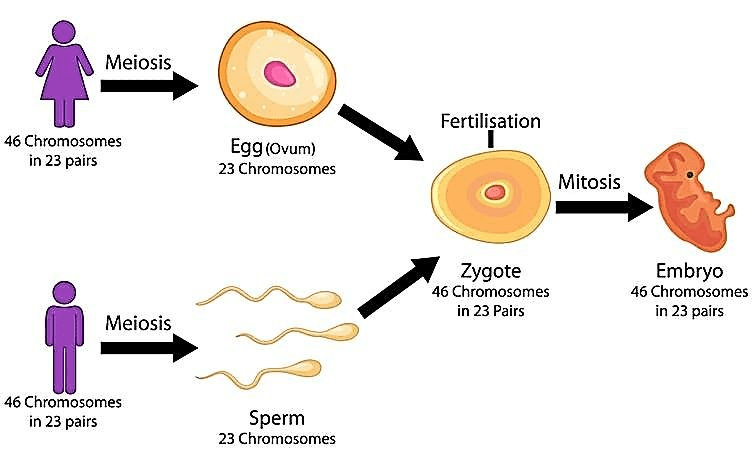
Meiosis: Creating Genetic Variation
Meiosis is the special type of cell division that produces gametes. Unlike normal cell division (mitosis), meiosis includes two key processes that create variation:
1. Independent assortment:
- Chromosomes line up randomly during division
- Each gamete gets a random mix of maternal and paternal chromosomes
- Creates 2²³ (over 8 million) possible combinations!
2. Crossing over (recombination):
- Chromosome pairs exchange segments of DNA
- Creates new combinations of alleles on the same chromosome
- Increases variation even further
These processes explain why siblings (except identical twins) look different despite having the same parents!
Predicting Inheritance: Genetic Crosses
Monohybrid Crosses
A monohybrid cross examines the inheritance of ONE characteristic controlled by a single gene with two alleles.
Example: Flower color in pea plants
- B = allele for blue flowers (dominant)
- b = allele for white flowers (recessive)
Let’s solve a genetic cross step by step:
Cross 1: Homozygous dominant × Homozygous recessive
Parents: BB (blue) × bb (white)
Step 1: Determine gametes
- BB parent can only produce B gametes
- bb parent can only produce b gametes
Step 2: Draw Punnett square
B B
________________
b | Bb | Bb |
|______|______|
b | Bb | Bb |
|______|______|Results:
- Genotype ratio: 4 Bb (all heterozygous)
- Phenotype ratio: 4 blue : 0 white (all blue flowers)
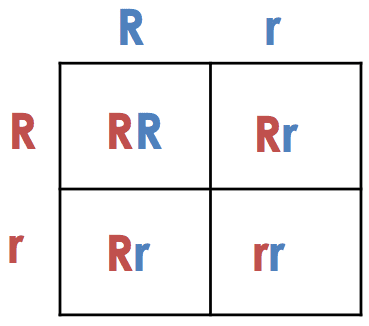
Cross 2: Heterozygous × Heterozygous (F1 cross)
Parents: Bb (blue) × Bb (blue)
Step 1: Determine gametes
- Each Bb parent can produce B or b gametes
Step 2: Draw Punnett square
B b
________________
B | BB | Bb |
|______|______|
b | Bb | bb |
|______|______|Results:
- Genotype ratio: 1 BB : 2 Bb : 1 bb
- Phenotype ratio: 3 blue : 1 white
This 3:1 ratio is the classic Mendelian ratio for a monohybrid cross between two heterozygotes!
Key Terminology for Crosses
Homozygous vs. Heterozygous:
- Homozygous: Two identical alleles (BB or bb) – “pure-breeding”
- Heterozygous: Two different alleles (Bb) – “hybrid”
Codominance:
In some cases, both alleles express themselves equally. Classic example: blood groups!
Example: Blood type AB
- Allele Iᴬ (produces A antigens) and allele Iᴮ (produces B antigens) are both expressed
- Person with IᴬIᴮ genotype has AB blood type (both A and B antigens on red blood cells)
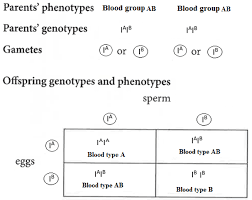
Test Cross (Backcross)
Sometimes you can observe an organism’s phenotype but want to determine if it’s homozygous dominant (BB) or heterozygous (Bb). A test cross solves this problem!
Method: Cross the unknown individual with a homozygous recessive individual (bb)
If unknown is BB:
BB × bb → All offspring are Bb (all show dominant phenotype)
If unknown is Bb:
Bb × bb → 50% Bb, 50% bb (half show dominant, half show recessive phenotype)
By observing the offspring, you can deduce the unknown parent’s genotype!
Sex Determination and Sex-Linked Inheritance
How Sex is Determined
Remember those sex chromosomes? They determine biological sex:
- Female: XX (homogametic – produces one type of gamete)
- Male: XY (heterogametic – produces two types of gametes)
Sex determination cross:
Parents: XX (female) × XY (male)
X X
________________
X | XX | XX | (Female)
|______|______|
Y | XY | XY | (Male)
|______|______|Result: 50% chance of female (XX), 50% chance of male (XY)
Important note: The father’s sperm determines the baby’s sex, as only sperm can carry a Y chromosome!

Sex-Linked Characteristics
Some genes are located on the X chromosome. These show sex-linked inheritance patterns.
Classic example: Red-green color blindness
- Gene for color vision is on the X chromosome
- Allele for normal vision (Xᴺ) is dominant
- Allele for color blindness (Xᶜ) is recessive
Why are males more likely to be color blind?
- Males have only ONE X chromosome (XY)
- If that X carries the recessive allele (XᶜY), they’re color blind
- Females need TWO recessive alleles (XᶜXᶜ) to be color blind
- A female with XᴺXᶜ is a carrier – she has normal vision but can pass color blindness to sons
Example cross: Carrier female × Normal male
Parents: XᴺXᶜ × XᴺY
Xᴺ Xᶜ
________________
Xᴺ | XᴺXᴺ | XᴺXᶜ |
|______|______|
Y | XᴺY | XᶜY |
|______|______|Results:
- 25% normal females (XᴺXᴺ)
- 25% carrier females (XᴺXᶜ)
- 25% normal males (XᴺY)
- 25% color blind males (XᶜY)
Key insight: Carrier mothers can pass sex-linked conditions to their sons, even though they don’t show the condition themselves!
Variation: Why We’re All Unique
Types of Variation
1. Continuous variation:
- Characteristics that show a range of values
- Controlled by multiple genes (polygenic)
- Influenced by environment
- Examples: height, skin color, intelligence, weight
- Shows a bell-shaped curve (normal distribution) when plotted
2. Discontinuous variation:
- Characteristics that fall into distinct categories
- Usually controlled by one or few genes
- Little environmental influence
- Examples: blood group, ability to roll tongue, attached/free earlobes
- Shows a bar chart pattern when plotted
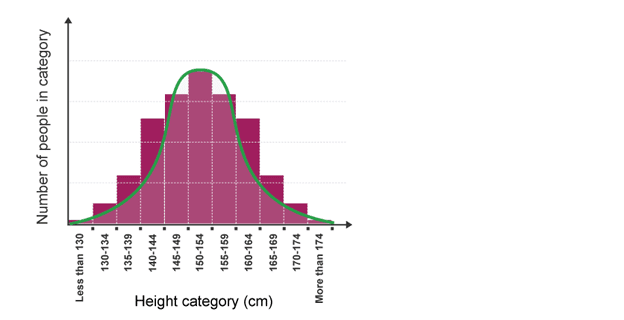
Causes of Variation
Genetic factors:
- Mutation: Random changes in DNA sequence creating new alleles
- Meiosis: Independent assortment and crossing over
- Fertilization: Random fusion of gametes
- Sexual reproduction: Combining genetic material from two parents
Environmental factors:
- Nutrition (affects growth and development)
- Exercise (affects muscle development)
- Sunlight exposure (affects vitamin D and skin color)
- Disease and injury
- Learning and experience (affects skills and knowledge)
Important: Most characteristics result from BOTH genetic and environmental factors working together. For example:
- Your maximum potential height is genetic
- Whether you reach that height depends on nutrition and health (environmental)
Mutations: Changes in DNA
What Are Mutations?
A mutation is a random change in the DNA sequence. Mutations are:
- The ultimate source of new alleles
- Usually harmful or neutral
- Rarely beneficial
- Can be passed to offspring only if they occur in gametes (sex cells)
Types of gene mutations:
- Insertion: An extra base is added to the DNA sequence
- Deletion: A base is removed from the DNA sequence
- Substitution: One base is replaced by a different base
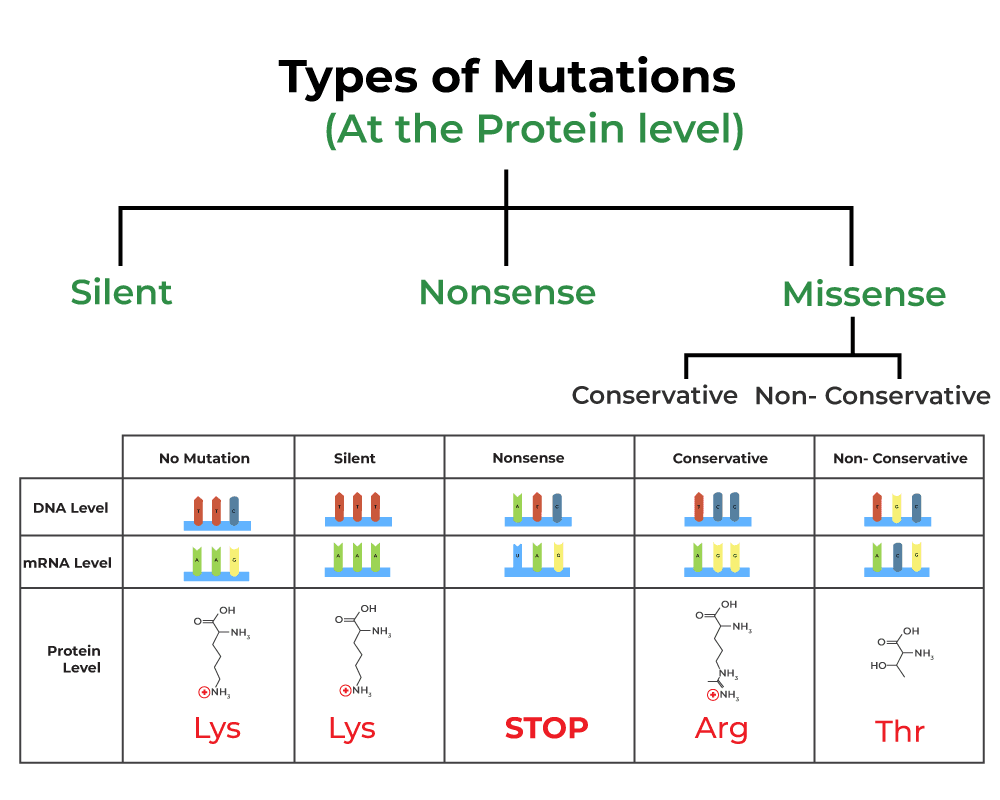
Mutation Causes and Effects
Causes of mutations:
- Ionizing radiation: X-rays, gamma rays, UV light
- Chemical mutagens: Certain chemicals in tobacco smoke, some pesticides
- Spontaneous errors: Random mistakes during DNA replication
Effects on organisms:
- Harmful: Most mutations disrupt normal protein function (e.g., sickle cell anemia, cystic fibrosis)
- Neutral: Many mutations have no noticeable effect
- Beneficial: Rare but crucial for evolution (e.g., antibiotic resistance in bacteria)
Sickle cell anemia example:
- Single base substitution in hemoglobin gene
- Changes one amino acid in hemoglobin protein
- Results in sickle-shaped red blood cells
- Causes pain, organ damage, and shortened lifespan
- Recessive condition (both alleles must be mutated)
Common Mistakes to Avoid
1. Confusing genotype and phenotype
- Genotype = genetic makeup (letters: BB, Bb, bb)
- Phenotype = observable characteristic (blue flowers, white flowers)
2. Using the wrong case for alleles
- ALWAYS use capital letters for dominant, lowercase for recessive
- BB and Bb both show dominant phenotype; only bb shows recessive
3. Forgetting to show gametes
- In exam answers, always state what gametes each parent produces
- This shows your understanding of meiosis and inheritance
4. Mixing up male and female symbols
- XX = female, XY = male (not the other way around!)
5. Thinking parents always pass on their phenotype
- Heterozygous parents (Bb) can have recessive offspring (bb)
- Two brown-eyed parents (both Bb) can have a blue-eyed child (bb)
6. Ignoring environmental factors
- Remember: phenotype = genotype + environment
- Identical genotypes can produce different phenotypes in different environments
Key Formulas & Equations Box
Important Definitions:
- Gene: Section of DNA coding for a protein
- Allele: Different form of a gene
- Dominant allele: Shows effect with one copy (capital letter)
- Recessive allele: Shows effect with two copies (lowercase letter)
- Homozygous: Two identical alleles (AA or aa)
- Heterozygous: Two different alleles (Aa)
- Genotype: Genetic makeup
- Phenotype: Observable characteristic
Base Pairing Rules:
- A pairs with T
- G pairs with C
Chromosome Numbers:
- Body cells: 46 chromosomes (diploid, 2n)
- Gametes: 23 chromosomes (haploid, n)
Classic Ratios:
- Monohybrid cross (Aa × Aa): 3:1 phenotype ratio, 1:2:1 genotype ratio
- Test cross (Aa × aa): 1:1 ratio
- Sex determination (XX × XY): 1:1 male:female ratio
Quick Revision Notes
Inheritance Basics:
DNA → Chromosomes → Genes → Alleles
Humans: 46 chromosomes (23 pairs), diploid in body cells
Gametes: 23 chromosomes, haploid
Fertilization: Restores diploid number (23 + 23 = 46)
Key Processes:
Meiosis creates variation through independent assortment and crossing over
Dominant alleles mask recessive alleles
Heterozygous individuals carry one of each allele
Punnett Squares:
Show all possible offspring genotypes
Calculate ratios of genotypes and phenotypes
Predict probability of characteristics
Sex Determination:
Female = XX, Male = XY
Male gametes determine offspring sex
Sex-linked genes on X chromosome
Males more affected by X-linked recessive conditions
Variation:
Continuous: Range of values, polygenic, environmental influence
Discontinuous: Distinct categories, single/few genes
Sources: Mutation, meiosis, sexual reproduction, environment
Mutations:
Random DNA changes
Types: Insertion, deletion, substitution
Mostly harmful, rarely beneficial
Can create new alleles
Test Yourself: Practice Questions
Question 1: A plant with purple flowers (genotype Pp) is crossed with a plant with white flowers (pp). Purple is dominant over white.
a) What gametes can each parent produce?
b) Draw a Punnett square for this cross
c) What is the ratio of purple to white offspring?
Question 2: Explain why males are more likely than females to be color blind, given that color blindness is a sex-linked recessive characteristic.
Question 3: A man with blood group A (genotype Iᴬi) has children with a woman with blood group B (genotype Iᴮi). What blood groups are possible in their children? Show your working.
Question 4: Distinguish between continuous and discontinuous variation, giving two examples of each.
Question 5: Explain how meiosis produces genetic variation in gametes.
Question 6: A mouse breeder has a black mouse but doesn’t know if it’s homozygous (BB) or heterozygous (Bb). Describe how a test cross could determine this.
Answers (Brief):
1a) Pp produces P or p gametes; pp produces only p gametes
1b) Punnett square shows Pp, Pp, pp, pp
1c) 2 purple : 2 white (or 1:1 ratio)
2) Males have only one X chromosome (XY), so one recessive allele causes color blindness. Females need two recessive alleles (one on each X) to be color blind.
3) Possible offspring: IᴬIᴮ (AB), Iᴬi (A), Iᴮi (B), ii (O) – all four blood groups possible!
4) Continuous: Height, weight (range of values, polygenic, environmental). Discontinuous: Blood group, eye color (distinct categories, single/few genes).
5) Independent assortment (random chromosome distribution) and crossing over (chromosome segments exchange) create new allele combinations.
6) Cross the black mouse with a white mouse (bb). If all offspring are black, original mouse is BB. If approximately 50% are white, original mouse is Bb.
Important Exam-Style Questions
Short Answer Questions:
- Define the term ‘allele’. (2 marks)
- State the base-pairing rules in DNA. (2 marks)
- Explain the difference between genotype and phenotype. (2 marks)
- State two ways in which meiosis produces variation. (2 marks)
Structured Questions:
- The diagram shows a family tree for the inheritance of cystic fibrosis (recessive condition).
a) State the genotypes of individuals A and B. (2 marks)
b) Explain why individual C does not have cystic fibrosis. (2 marks)
c) If individual C has children with a carrier, what is the probability their child has cystic fibrosis? (3 marks) - A farmer crosses red-flowered plants (RR) with white-flowered plants (rr). Pink flowers (Rr) result, showing incomplete dominance.
a) Complete a genetic diagram for this cross. (4 marks)
b) The farmer then crosses two pink-flowered plants. Predict the ratio of flower colors in offspring. (4 marks)
Extended Response:
- Discuss how variation arises in sexually reproducing organisms. (6 marks)
- Explain the inheritance of sex-linked characteristics, using an example. (6 marks)
Study Tips for Exam Success
1. Master the vocabulary:
Create flashcards for all key terms. Genetics has specific terminology that must be used precisely in exams.
2. Practice Punnett squares daily:
Work through different scenarios until you can draw them confidently in under 2 minutes. Practice with monohybrid crosses, sex determination, and sex-linked inheritance.
3. Learn the standard format:
Exam answers should follow this structure:
- State the parent genotypes
- Show the gametes
- Complete the Punnett square
- State the offspring ratios
- Answer the specific question
4. Understand, don’t memorize:
Rather than memorizing crosses, understand WHY offspring have certain characteristics. This helps you tackle unfamiliar scenarios.
5. Draw clear, labeled diagrams:
Practice drawing DNA structure, chromosomes, and cell division. Use rulers and labels clearly in exams.
6. Use past papers:
Cambridge publishes past papers and mark schemes. Practice with these under timed conditions to familiarize yourself with question styles.
7. Connect to real life:
Relate topics to your own family, genetic conditions in the news, or breeding of pets. Real-world connections aid memory.
8. Watch out for command words:
- “State” = brief answer
- “Explain” = give reasons
- “Describe” = give details
- “Compare” = similarities and differences
Conclusion: You’ve Got This!
Congratulations! You’ve just navigated through one of biology’s most fascinating topics. Inheritance explains the very essence of what makes you unique, connects you to your ancestors, and influences future generations.
Understanding genetics opens doors to exciting fields: medicine (gene therapy, personalized medicine), agriculture (crop improvement, selective breeding), forensics (DNA fingerprinting), and evolutionary biology. The concepts you’ve learned here form the foundation for advanced biological sciences.
Your next steps:
- Practice, practice, practice: Complete the test yourself questions above and find more problems in your textbook
- Create summary sheets: Condense these notes into one-page revision aids
- Teach someone else: Explaining concepts to others reinforces your understanding
- Explore related topics: Look into Topic 18 (Variation and Selection) and Topic 5 (Enzymes and Proteins) for connections
- Stay curious: Watch documentaries about genetics, read articles about genetic breakthroughs, and connect classroom learning to real-world applications
Remember: Every geneticist, doctor, and researcher started exactly where you are now. With consistent practice and genuine curiosity, you’ll not only excel in your IGCSE exams but develop a lifelong appreciation for the elegant complexity of heredity.
The genetic code that makes you you is approximately 3 billion base pairs long, yet it can be understood through the simple principles you’ve learned today. That’s the beautiful thing about biology-complexity built on fundamental, understandable rules.
Now go forth and ace that exam! You have the knowledge, the practice questions, and the understanding to succeed. Your genetic inheritance gave you a remarkable brain-use it wisely, study effectively, and believe in your ability to master this material.
Recommended –

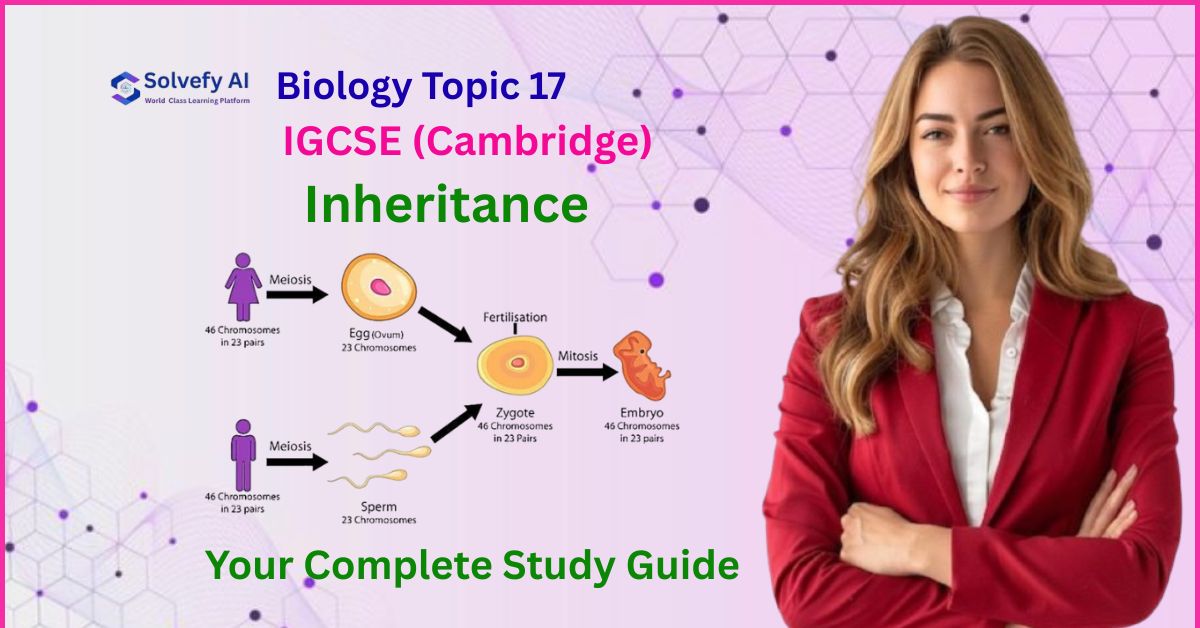
1 thought on “Inheritance | IGCSE Biology Topic 17 Complete Guide”